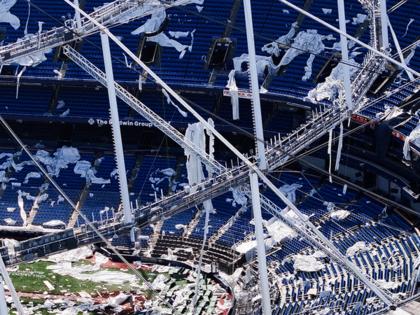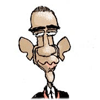John Romano: Stuart Sternberg could sell the Rays, but it may not be a quick resolution
Published in Baseball
ST. PETERSBURG, Fla. — Tropicana Field may not have a roof, but Tampa Bay does have rumors.
Do you like the one about Stuart Sternberg selling the team, or the one about a new stadium plan in Tampa? Should we discuss the hard-to-believe whispers that the Seminole Tribe is interested in baseball, or the aptly named group of Dreamers in Orlando?
Spring is approaching, innuendo is blooming and the ceiling in the Rays clubhouse is dripping.
Um, play bawl?
It’s been six months since Tampa Bay’s stadium situation was seemingly resolved, a little more than three months since the hurricanes hit and seemingly forever since we went through an offseason without some level of crisis involving money, stadium or ownership speculation.
It may feel as if we’re heading toward a crescendo, but we’ve heard the clanging of cymbals before.
The Rays have not tipped their hand since mid-December when the Pinellas County Commission agreed to approve bonds for a new stadium, albeit seven weeks after the team was banking on the affirmative vote.
Now Sternberg has until March 31 to meet all the conditions to proceed with the redevelopment of the Historic Gas Plant District and the building of the pavilion-style ballpark on the Trop property. It should be a formality, but it could end up being a fork in the road.
Let me explain:
Baseball commissioner Rob Manfred did Tampa Bay fans a huge favor by seemingly reaffirming the game’s commitment to the market, and by pressuring the Rays into agreeing with St. Pete’s plans to repair the Trop in time for the 2026 season.
While that limited the team’s options in terms of a temporary, or even permanent relocation, the idea that the team will have a facility in St. Pete through the 2028 season may have provided the Rays with a longer runway to decide their next move.
Which may lessen the urgency of a potential sale in the coming months.
Ever since Pinellas commissioners delayed the bond sales in October and Sternberg said the team no longer felt it had a partner in the county, the most logical outcome appeared to be the sale of the team. Sternberg insisted the delay had driven up the stadium’s price, but county and city officials said there was no verifiable evidence of soaring costs. And, besides, the development agreement made the Rays responsible for cost overruns.
That stalemate convinced some local leaders to begin assembling potential ownership groups to buy the team and either continue with the Trop redevelopment, or consider alternatives in Hillsborough County. Up until a few months ago, the Rays had been looking for investors to buy minority shares in the team, which would have provided a cash infusion for stadium construction, but Sternberg now appears more focused on selling the team outright.
Could that happen before the Rays’ opening day (March 28)?
It’s certainly possible.
But there’s also a scenario where the Rays let the Gas Plant/stadium deal lapse on March 31 and continue a business-as-usual stance for the foreseeable future.
Why would they do that?
Lots of reasons. They could be encouraged by the early response to ticket sales at Steinbrenner Field for 2025. Despite significant price increases, sales for high-end season tickets have gone exceptionally well. That would seem to verify the theory that there’s more money to be made in Tampa.
If the Gas Plant stadium deal was still in effect, neither Sternberg nor a potential new owner could talk to Tampa officials about a facility on that side of the bay. By letting the new stadium deal expire, any Rays owner would be free to immediately begin discussions about a ballpark in Hillsborough that would open in 2029.
Taking extra time before selling the team could also increase the pool of aspiring owners and drive the price up. When it comes to baseball operations, the Rays front office has outsmarted a lot of teams by buying low and selling high.
Also, from a cynical point of view, Manfred is not going to be in office forever and MLB’s view of Tampa Bay as a market could diminish if a hastily repaired Tropicana Field does not draw crowds from 2026-28.
The cost and extent of repairs at the Trop is still very much an open question. A consultant’s report on the repair indicated roof replacement would not begin until at least June. That opens the possibility of a lot of rain between now and getting the stadium covered. Even minimal rain showers in January left standing water in various places inside the stadium, including buckets in the home clubhouse to capture dripping water.
Continued damage, and mold possibilities, could increase the cost and limit non-essential repairs of the facility.
For comparison’s sake, the slow deterioration of the Oakland Coliseum in recent years played a role in lower attendance and an eventual relocation to Las Vegas. If the Trop and Tampa Bay go through a similar winddown, it could reopen the possibility of a sale to an owner interested in moving the team.
And that’s not even considering the potential lawsuits the Rays seem to be pondering based on correspondence with the the city.
So, as you can see, potential options remain plentiful.
It still seems likely that Sternberg will eventually sell the team — if the March 31 deadline is not met it’s hard to imagine another stadium deal between Sternberg and Pinellas — but the possibility of the Trop being available from 2026-28 could mean the status quo remains in effect for a while.
Not to mention, continued uncertainty for the near future.
____
©2025 Tampa Bay Times. Visit tampabay.com. Distributed by Tribune Content Agency, LLC.







Comments